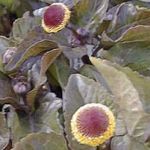| Common Name: |
Toothache Plant |
| Botanical Name: |
Spilanthes acmella syn S. paniculata |
| Genus: |
Spilanthes |
| Family: |
Asteraceae |
| Native Location: |
S America; now pantropical in distribution. |
| Cultivation: |
Well-drained soil in sun. |
| Propagation: |
By seed sown in spring. |
| Harvest: |
Leaves, flowering plant, and flower heads are picked as required and used fresh. |
| Height: |
40-70cm (16-28in) |
| Width: |
40-70cm (16-28in) |
| Variants: |
Var. oleracea
syn. Oleracea
(Pará cress, Jambú, Brède Mafane)
Has larger, milder, purple-flushed leaves. |
|
| Hardiness: |
Z9 |
| Parts Used: |
Leaves, flower heads. |
| Properties: |
An aromatic, pungent, expectorant herb that improves digestion and has anesthetic and insecticidal effects. It stimulates the salivary glads, increasing salivation. |
| Medicinal Uses: |
Internally for dyspepsia and bronchitis (flowering plant). Externally for toothache, sore mouth and gums, burns, scalds, headaches, migraine, itching skin conditions; also in India as a popular remedy for stammering in children (flower heads). |
| Culinary Uses: |
Leaves (especially of the variety oleracea) are added to salads or cooked in coconut milk. An important ingredient of Amazonian soups pato no tucupi and tacacá, and main ingredient of Malagasy national dish, roumazave. |
| Bibliography: |
The Encyclopedia or Herbs by Deni Bown Copyright © 1995, 2001 Dorling Kindersley Limited. pp. 373-374 |

